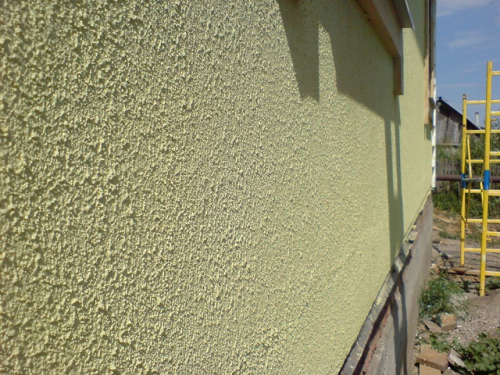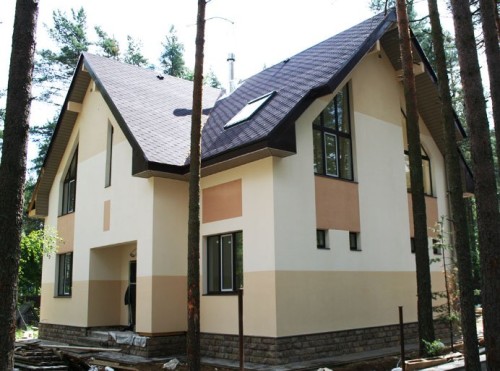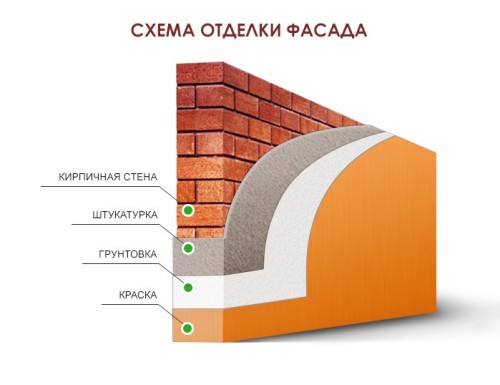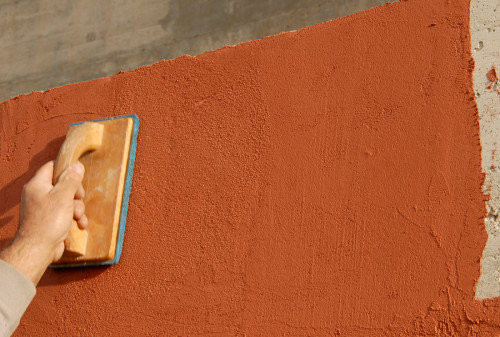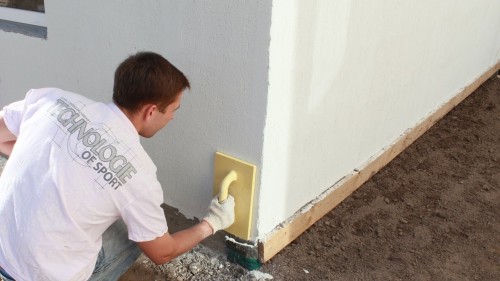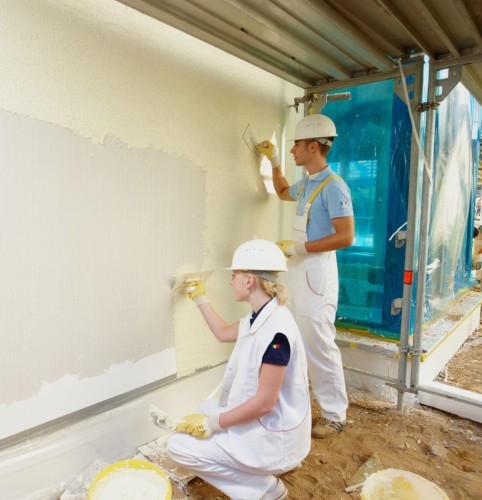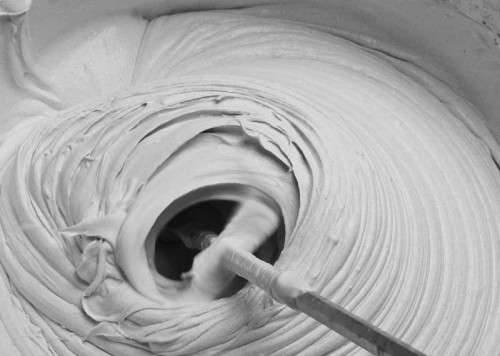
Putty facade: properties, choice, application Building materials
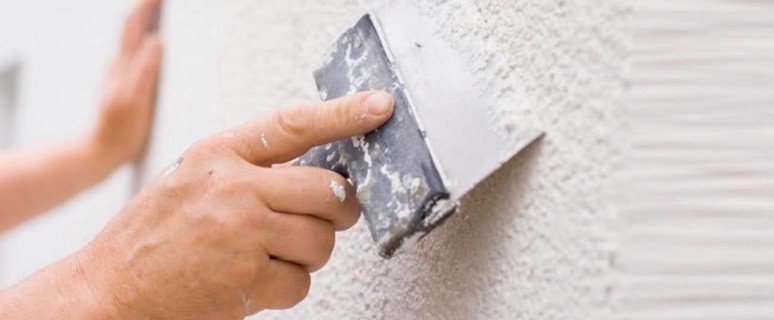
The outer facing of the building is a fairly painstaking process for which many different materials can be involved. Each of them requires work skills and minimal knowledge in the construction area. In this article, we will consider the features of the choice and use of such a material as the fastener putty - one of the most common in use, with high performance characteristics.
Content
Properties of the composition
Traditionally, putty for facade works is used to align and thermal insulation of surfaces of various types. Using this composition, you can disguise the relief, visual defects (chips, gaps, seams), roughness of walls from any material (stone, brick, foam concrete, plaster, concrete, etc.). In addition, due to the high indicators of frost-resistant and moisture resistance, cement putty is used to design the facades of unheated buildings.
As a rule, the facade putty includes such components:
- cement;
- modifying additives;
- specific mineral fillers;
- special plasticizers.
Fastener Putty: Specifications
The main purpose of the facade putty for external work is to form a protective and decorative coating of the facade at the same time. Such cladding is capable of creating a test layer from external atmospheric factors that entail the feeding and destruction of the structure. These characteristics are ensured by such properties of cement putty, as:
- Resistance to climatic changes, in particular temperature differences. Qualitative compositions have sufficient resistance to the effects of intensive radiation of ultraviolet, atmospheric precipitation, wind, and some species of putty even provide protection against radiation compounds. This property is especially relevant for regions, where the outer temperature changes are very significant.
- Moisture resistance. The cement putty coating is not damaged under the influence of moisture, and also creates a protective barrier from its penetration inside the trim, which often entails destructive consequences.
- Ensuring the sound and thermal insulation quality of the structure. The use of facade putty allows you to save on the use of heat-insulating materials, which leads to low costs for the heating of the building. In addition, this finish allows to reduce the level of street noise.
- Coating strength. The facade part of the buildings is experiencing mechanical loads and damage. However, this type of finish is withstanding their harmful effects, extending the life of the building.
- Good vapor permeability. The ability to putty the finishing facade passes the air allows to maintain the initial structure of the surfaces of the facade.
- Design variability. With this finishing material, you can create various textures and texture of the coating, and a wide color range will make the facade as suitable as possible under the landscape design of the structure and the site. Undoubtedly, the consumption of wipers of facade will increase in this case, however, the homeowner will be able to implement various design ideas in practice. Cement finish comes on sale both in factory shades and in universal white color, which can be shed at its discretion. You can improvise with texture using stencil.
- Available cost. When comparing the most popular finishing materials, the average price range of the facade putty is relatively different from the analogues. The cost is formed depending on the final structure of the coating, the characteristics of the components included in the material.
- Simplicity of application. For the design of the facade, it will not be necessary to attract a construction team, because All work can be performed independently.
The presented qualities are characteristic of all types of cement putty, however, depending on the variety of the facade mixture and its composition, the degree of severity of certain properties can be varied.
Putty facade acrylic
The facing composition made on the basis of acrylic is characterized by high plasticity and endurance. Such a putty is better to apply on the surface with a low indicator of vapor permeability (polyurethane foam insulation, polystyrene foam, etc.). Due to the presence of a special formula in the resinous components, the material is characterized by good elasticity and quite low absorption.
The facade treated with acrylic cement putty allows the walls to "breathe", deriving the depth of moisture clusters. This allows you to protect the building from the negative impact of breeding microorganisms, rotting, the appearance of fungal infection. The walls are well tolerated the difference in ambient temperature, as well as atmospheric influences.
Nevertheless, the surface treated with putty on an acrylic basis, during operation, is characterized by an average self-cleaning degree and require additional facade care procedures.
Mineral facade plaster
This type of cement facade putty refers to the most economical and universal. Such qualities are achieved due to a cement-based composition, which is complemented by various chemical components. Such inclusions increase the operational parameters of the putty, increasing the resistance to the humid environment. The treated facade is characterized by sufficient strength, wear resistance to mechanical factors of impact and precipitation.
Manufacturers of facade putty on mineral base, as a rule, use a limited color palette. In this regard, if necessary, to make the surface of the building of the original shade, you should use a tinting or apply additional staining.
This composition is most simple in preparation, so it can be used independently, strictly adhering to the proportions indicated by the manufacturer. This condition is quite important, since the minimum deviation from the prescriptions of the manufacturer can lead to difficulties in applying cladding layers, as well as deterioration of the properties of the material.
Silicate-based powder
Silicate putty is manufactured on the basis of "liquid" potash glass. This type of facing material is characterized by the highest vapor-permeable ability and hydrophobicity. Due to which it is used, as a rule, on top of insulation from mineral wool. Silicate putty enters the sale already in the finished form, so before applying to the wall of the wall, it is necessary to simply stir.
The good elasticity of the finish finish ensures the strength of the coating, so that the facade does not crack under the influence of precipitation, intensive solar radiation and small mechanical damage. In addition, the silicate putty attaches the facade the property of antistatic, due to which the walls do not attract dust. Accordingly, such surfaces retain cleanliness for a long time, aesthetics and well cleaned.
Among the disadvantages of such a facing coating, it is possible to distinguish quick grasp. It is necessary to apply the composition extremely quickly until it hardened what requires a master of a certain skill. Also manufacturers limit the color gamut of the material, so it is necessary to select a shade from the factory palette. In addition, before applying putty, you need to process the surface with a special primer.
Silicone-based powder
The presented view of the facade putty is the most versatile for all types of surfaces, which is reflected in the cost of products. Such cladding guarantees reliable protection against climatic factors, incl. Drops of temperature, precipitation, solar radiation. In addition, silicone putty is characterized by a high record permeability, which allows the walls to "breathe". This, in turn, eliminates the risk of malicious microorganisms inside a wall cake. Also, such material has good dirt-repellent properties, so that the facade retains the aesthetic form of finishes over long life.
Despite the fairly high cost of putty, it comes on sale in a wide range of color schemes, which allows you to choose the desired shade of facing or combine several options at once.
Terms of application of the composition
- Putty for the facade, regardless of the form, is a ready-made dry or pasty mixture, which must be diluted with water before applying to the wall. Therefore, to achieve the maximum efficiency of the result, the instructions for use should be clearly followed, withstanding the proportions, the order of operations and the time stated by the manufacturer.
- For mixing the solution, an electric door with a screw or frame nozzle is allowed, which issues 500-800 rpm.
- It is strictly not recommended to use a transient chipper for these fools, since the intensive stirring of the composition leads to a deterioration in operational qualities and a decrease in the service life of the finish.
- The optimal variant for mixing the solution is a building mixer with a long nozzle.
- If necessary, the finishing finish can be applied using a pneumatic spraying device. However, in this case, it will be necessary to introduce an additional solvent.
- When finishing works, the facade putty borehole either the material of any other manufacturer is allowed to use a stainless grater with rounded corners, standard spatulas of the desired width (plastic, rubber or metal).
- To predict the surface of the original texture, it is necessary to use a special plastic grater.
- Watching the facade surface is allowed to produce with stable ambient temperature + 5 ... + 25 ° C. However, the optimal temperature range will be indicated by the manufacturer on the packaging of the composition.
- If the work is performed in the summer season, it is desirable to protect the surface of the facade from direct sunlight using a grid.
- The permissible humidity of air for applying putty is no more than 80%, and the base indicator should not exceed 10%. Ignoring these requirements will negatively affect the quality of the coating and its durability.
- Spoile the quality of the plastering layer can also precipitate and strong wind. For this reason, it is not necessary to save on the preparation of shelter.
How to apply putty
The process of applying a facade putty occurs in such a sequence of actions:
- Initially, it is necessary to prepare a container for stirring. Suitable deep bucket or pelvis.
- In container, pour the required amount of water, the volume of which will be indicated on the packaging of products, and fall asleep dry mixture. Mix the solution thoroughly with a construction mixer for 2-3 minutes.
- Then the putty should be given for several minutes. After that, the composition is mixed again.
- Properly prepared composition has a homogeneous consistency, without air bubbles and lumps.
Important! Since the putty dry sufficiently dries outdoors, it is necessary to knead the composition of the portion. Add water to the already thickened solution is prohibited, because He will lose its performance characteristics. Also try to keep the buckets with the finished putty closed.
- With a spatula or grater, it is necessary to deliver the solution to the surface of the wall and to dissolve the circular motion in the direction from itself.
- Similarly, the entire surface of the facade is covered. In the case of the use of a textured spatula to give the original relief, it is important to take into account the properties of the selected putty, because It is amenable to modeling for a limited time. Then quickly grasps and dries.
Due to the features of the facade putty, the coating is easy to stain in the infinite set of shades in the process of preparing the solution to use. This provides uniform painting throughout the coating thickness, which, as is well known, is a guarantee of high surface stability to the effects of ultraviolet rays and fading.
Video instructions for applying putty:




